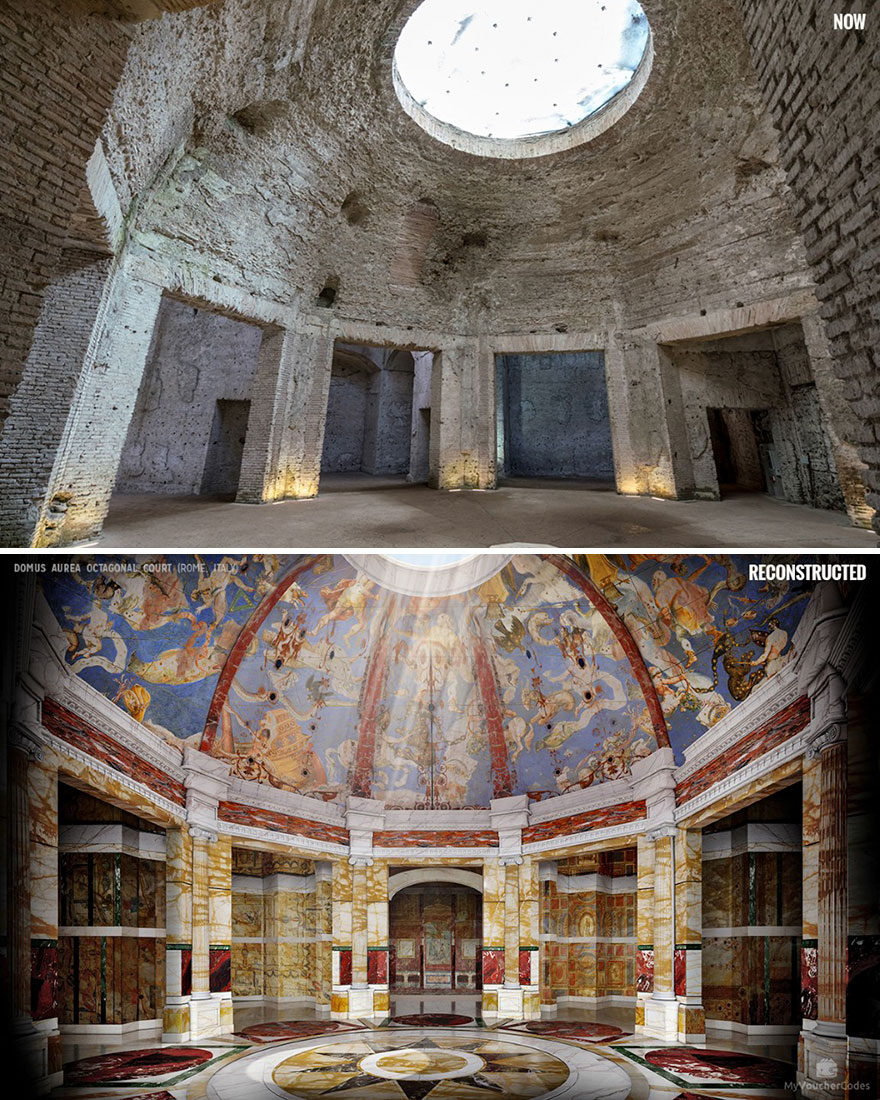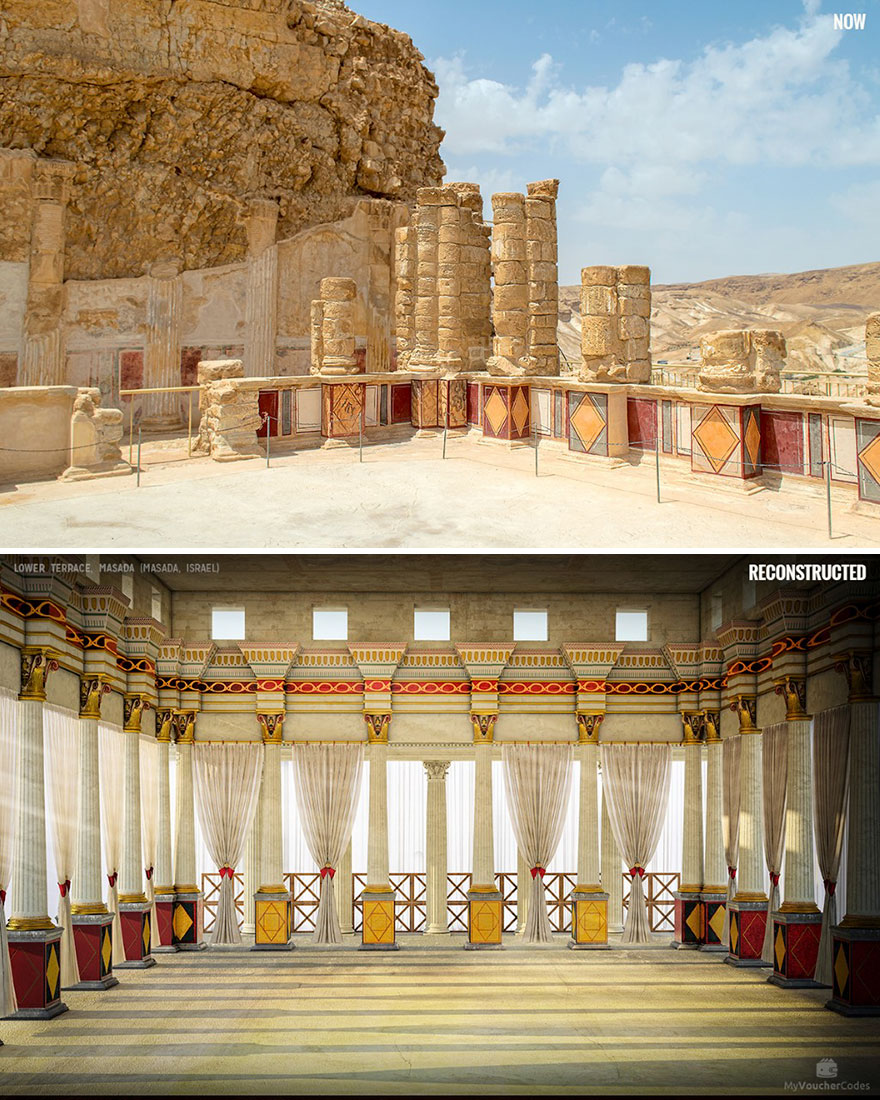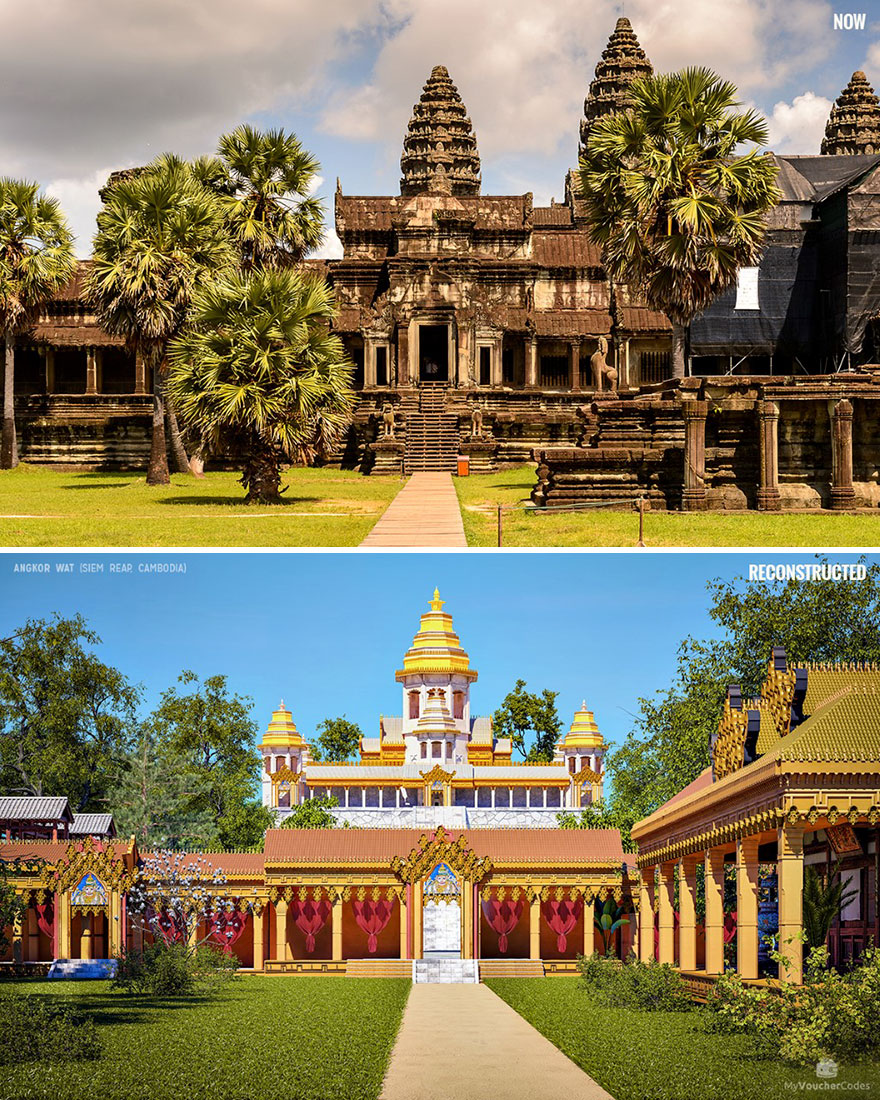In a world that moves forwards quickly and relentlessly, we’re so lucky to still have the ruins of ancient history to remind us of our past. But even though it’s inspiring to visit something that was built thousands of years ago, it’s not always easy to understand what it would the historical sites actually looked like.
Take the Parthenon in Athens, for example. Today it’s mostly a collection of very old pillars without a roof, because of an explosion that happened in the 17th Century, and all of its treasures, including a huge statue of the goddess Athena, are long gone.
Luckily a team of digital artists has gone through the trouble of digitally recreating what, according to the experts, the inside of the Parthenon would have looked like in all its original glory, and it’s an incredible place to see. They’ve done the reconstruction for six other famous historical places, from Angkor Wat in Cambodia to some Roman Baths in England, and the result is as close as you can get without jumping into a time machine.
One of the hardest things to imagine when looking at ancient ruins is seeing the kind of jewel-encrusted finery that was surely there in a room as grand as the Domus Aurea Octagonal Court in Rome. The famous building dates back to around 65 AD and was basically a party hall for Emperor Nero, so probably saw some crazy stuff and wouldn’t have looked out of place on MTV’s Cribs.
However, visiting it today you get to see a lot of bare walls and a dome. But with the help of some digital wizardry, you can really see a room fit for an Emperor and his posse, from the mosaic in the dome to walls covered in gems and flowers.
Scroll down to see all seven of these amazing ancient ruins brought back to life.
More info: myvouchercodes.co.uk
This post may include affiliate links.
Domus Aurea Octagonal Court (Rome, Italy)
Constructed between 65 and 68 AD by one of Rome's most notorious emperors, the eponymous Golden House of Nero was a lavish palace complex that played host to the Emperor’s wild parties and banquets. The large, octagonal room had a concrete dome, most likely covered in glass mosaic. Roman historian Suetonius tells us of a 'circular banquet hall, which revolved incessantly, day and night, like the heavens.' He describes gem-encrusted walls, ivory and mother-of-pearl decorations and ceilings that showered guests with flowers and perfumes. Sounds like the height of luxury.
Parthenon (Athens, Greece)
Sitting atop the hill at the Acropolis, the Parthenon was built in the mid-5th century BCE to house a monumental golden statue of Athena. We all know the outside of this iconic temple, but what went on inside? The gigantic statue was over 12 m high and made of carved ivory and gold – 1,140 kilos of gold, to be exact. A basin of water sat in front of Athena to provide humidity, which preserved the ivory. This obvious display of wealth and power sent a very clear message to the rest of the world. And for those lucky enough to see the Parthenon from the inside in its heyday, the statue must have been nothing less than awe-inspiring.
Basilica Of Maxentius (Rome, Italy)
This majestic building in the Forum Romanum was the greatest of all the Roman basilicas. Covering 6,500 square meters, it acted as a meeting house, commercial area and administrative building. It was designed in a grand fashion fit for its prime location and importance to the Roman government and public. The spectacular Corinthian columns, multi-colored marble floors and gilded bronze tile walls made this one of the most impressive buildings of Ancient Rome. The ornate details might have disappeared with time, but with this reconstruction you can get a sense of the basilica’s former opulence.
Lower Terrace, Masada (Masada, Israel)
According to Josephus Flavius, governor of Galilee, Herod the Great built the fortress of Masada between 37 and 31 BCE. It stands atop an isolated rock cliff overlooking the Dead Sea and is a place of undeniable majestic beauty. King Herod’s elegant, intimate residential palace consisted of three luxuriously built terraces. Here, we’ve reimagined the lower terrace, which was designed especially for entertainment and relaxation. It was surrounded by porticos, with walls covered in beautiful frescos of multi-colored geometric patterns. In case that doesn’t sound luxurious enough, there was also a small private bathhouse.
Roman Baths (Bath, England)
This bathhouse complex is a perfect example of the luxurious – and often ostentatious – Roman lifestyle. Constructed around 70 AD, the baths were an integral part of ancient Roman daily life. Offering citizens the chance to mingle, gossip and relax, the bathing culture showed the whole world just how superior (and clean) the Romans were. The steaming, geothermally heated water from the 'Sacred Spring' fills the Great Bath. While it’s in the open-air these days, the bath was originally covered by a 45m-high barrel-vaulted roof. This reconstruction lets you dip your toes in to get a little taste of the luxury.
The water at the old baths isn't safe. They won't even let you stick your hand in. However there is a modern spa in town that uses the water from the spring.
Great Kiva, Aztec Ruins National Monument (New Mexico, Usa)
These ruins were first discovered in 1859 and provide invaluable insight into the daily lives of the Pueblo people. Sprawled over 27 acres, the ruins boast over 450 rooms and include a fully restored kiva. Built partly underground, the ‘great kivas’ were huge, round structures where people gathered to socialize, discuss important issues of the day or tuck into a communal feast. Visitors can find the restored kiva by walking the original trails that lead through the ruins. And if you can’t make it to New Mexico, this reconstruction should give you an idea of how this great civilization lived.
Angkor Wat (Siem Reap, Cambodia)
Estimated to have taken around 30 years to construct, this complex was originally a Hindu temple dedicated to the god Vishnu. It transitioned to a Buddhist temple towards the end of the 12th century and is believed to be the world’s largest religious building. From afar, Angkor Wat appears to be one enormous mass of stone. Once inside, however, visitors will find a series of elevated towers, porches and, courtyards on different levels, linked by a series of stairways. We’ve recreated one of Angkor Wat’s lush courtyards, and we think it looks like the perfect place for some mindful walking.
Enjoyed these. I always wonder what ancient relics and ruins actually looked like.
Enjoyed these. I always wonder what ancient relics and ruins actually looked like.

 Dark Mode
Dark Mode 

 No fees, cancel anytime
No fees, cancel anytime 
















































